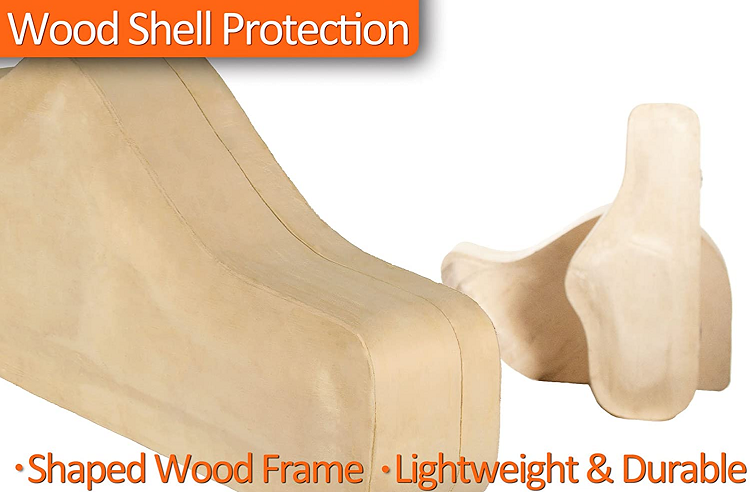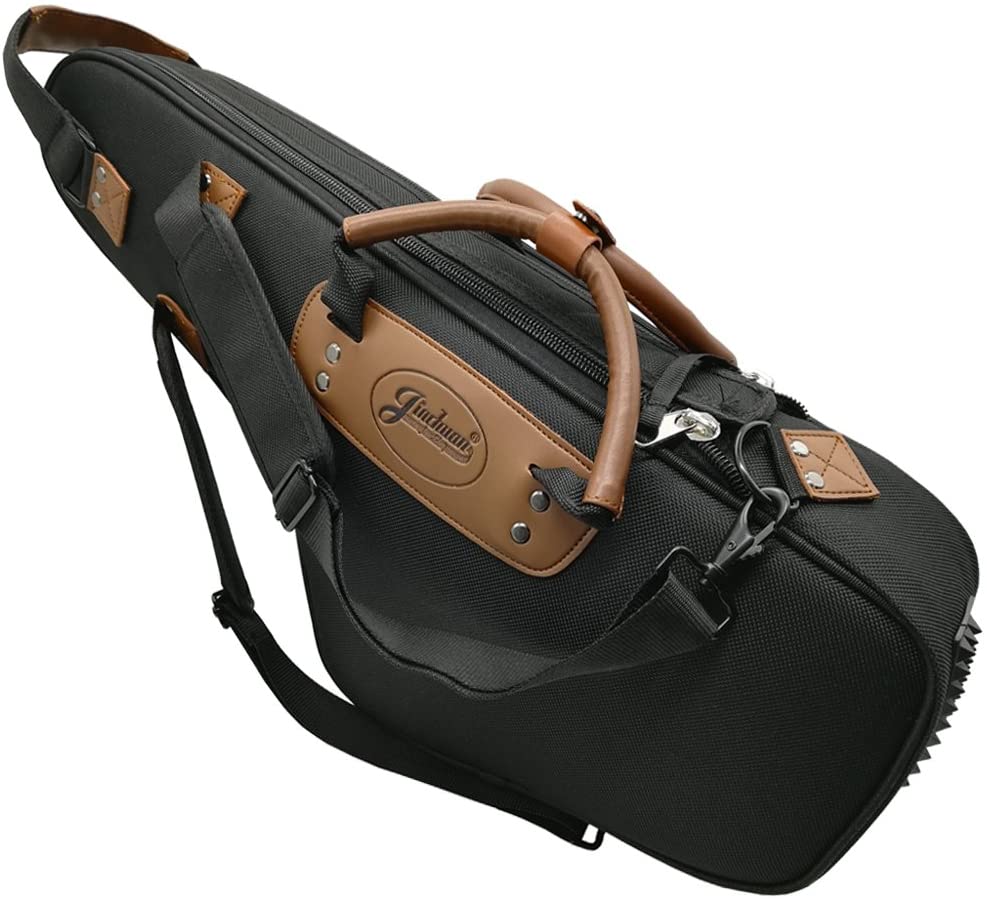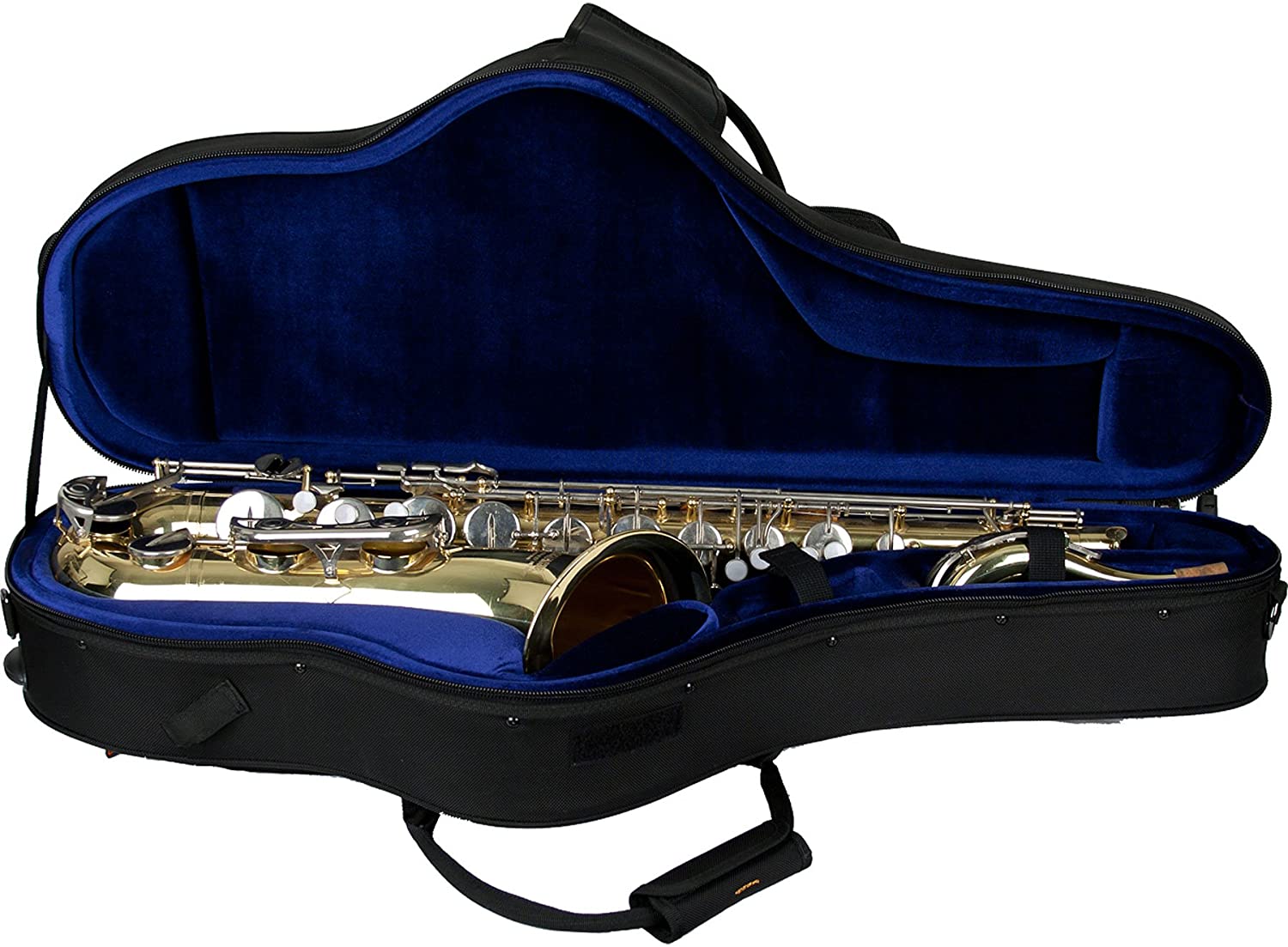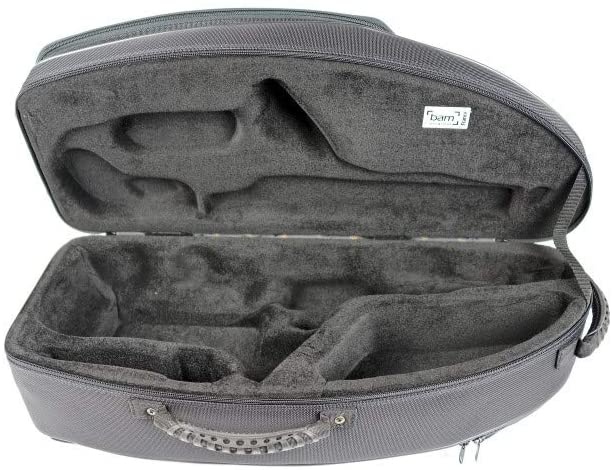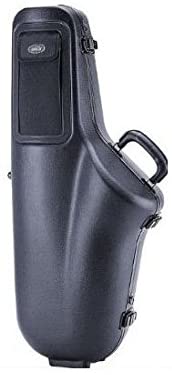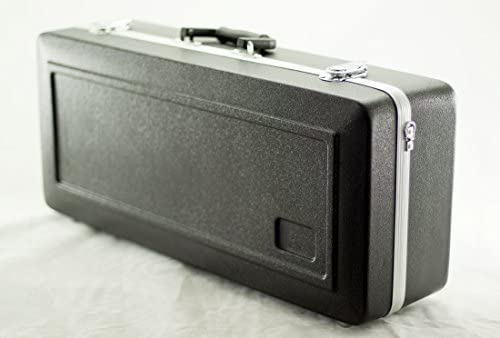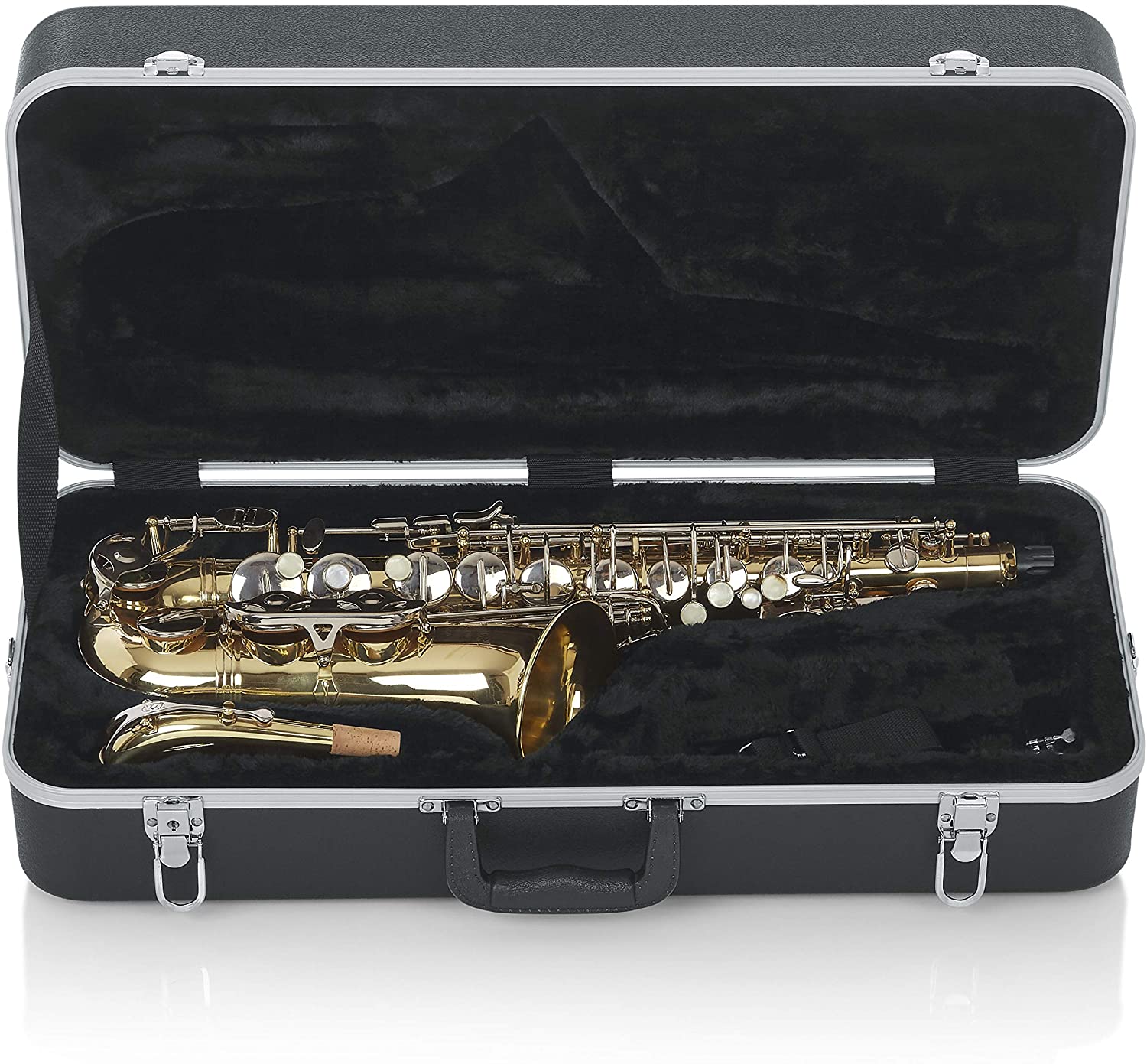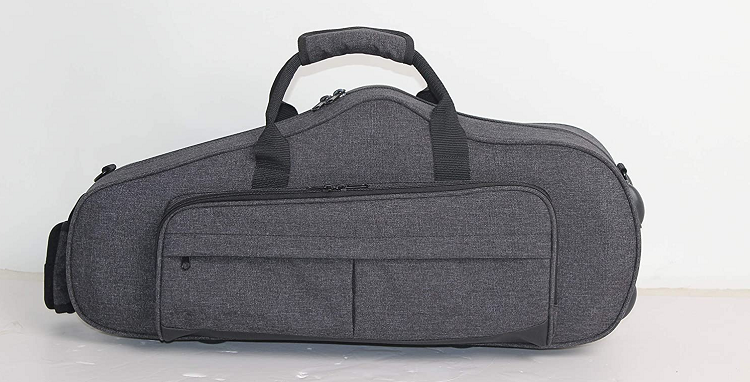- How to Find the Best 5 String Violins - April 19, 2022
- Top Violin Accessories to Consider - April 18, 2022
- Best Left-Handed Violins Guide - April 13, 2022
Summary: The best saxophone case options are based on your personal needs, how you like to transport your saxophone, and what type of storage options you need.
Bottomline Up Front
I recommend the BAM Saxophone Hard Shaped Case. This is well worth the initial investment if you want to protect your saxophone long-term.
It has an excellent rain guard that protects against inclement weather in a contoured shape with large pockets that hold everything you need. The weight of the case is not worsened by the solid exterior construction and interior foam.
Selection Criteria
When reviewing the best saxophone case options, I looked at the quality of the construction and the materials used. I also examined the size, shape, and ability to hold your instrument safely inside.
Good quality construction in your saxophone case means you are less likely to need a replacement or repair within a year or two. Given the financial investment that saxophone cases and saxophones are, it’s always worth investing in a high-quality product that will last a lifetime.
Why Choose the Best Saxophone Case Options
Whether a beginner or a professional, you need to invest in the best saxophone case options. Beginner musicians don’t need to transport their saxophone beyond music lessons or classes. Even beginner adults need a place to store their saxophone safely and protect against sun exposure, moisture, or dust.
Still, if your children are as prone to slipping and falling as mine are, or they hit their backpacks and bags against every corner they pass, getting a case can protect the investment you made in the saxophone.
Intermediate musicians need to invest in the best saxophone case options to be durable, a little more heavy-duty than a soft gig bag. Contoured shapes are an aesthetic feature that you can afford at this level.
Professional musicians might need box-shaped hard cases to store their saxophone and all electronic equipment or accessories. These types of professional case options are meant to be handled by multiple people, especially backstage crew members who might not treat the saxophone, as well as the owner does.
This is why having hard shell designs shaped like a box with heavy-duty hardware and extra internal padding is important.
Types of Designs
When you look at the best saxophone case options, you will see a few different designs:
Soft Shaped
The most affordable is the soft shaped bag. This is a travel case or storage case usually referred to as a gig bag. It doesn’t have any rigidity to the case, so you can easily travel with it. The reason professionals have a gig bag is to carry their saxophone to and from events within the local area without having to lug something oversized.
This is also what you commonly find among students or children. Because it’s the most affordable, it’s typically what comes with beginner saxophones. These are very comfortable to carry and incredibly lightweight. However, they have the least amount of protection for your instrument.
If you get a soft shaped bag, it has a contoured shape that fits your saxophone. Still, in the event that you drop your saxophone or someone runs into it, steps on it, or any other number of potential accidents, it won’t give it the same protection from dents, scraps, or further damage.
Hard Box
The hard box is one of the least convenient and most traditional types of saxophone cases. The hard box case is also colloquially referred to as the flight case because you can take it on a plane without any fear of damage in the cargo hold. It’s harder to carry than a contoured or shaped saxophone case, but it’s much more stable.
Because it is an actual box shape, it can be stacked with other instruments or other luggage, making it much easier to wheel on stage or four performances.
Most hard box cases offer a more comprehensive internal and external storage space than shaped cases. So, if you plan on carrying a lot of equipment or sheet music, this might be the best for you.
This video shows what accessories you might want to keep in your saxophone case:
Hard Shaped
A hard-shaped bag is contoured to fit your saxophone. Many convenient hard shaped saxophone cases give you a high level of protection but are suitable for travel. Many people like the aesthetic appeal of these best saxophone case options.
They come with things like backpack straps, making them easier to carry over your shoulder while keeping your hands-free.
Because they are a hard shape, you don’t have to worry about your saxophone hitting the perimeter or getting damaged when it hits anything else. It comes with reinforced Hardware, supportive interior compartments, and exterior pouches.
Cost for the Best Saxophone Case Options
The cost for the best saxophone case options varies dramatically depending on your design type. The flight boxes or hard shapes saxophone cases are the most expensive, and for a good reason.
These are designed with more physical material, sturdier and more expensive hardware, and better protection. By comparison, the beginner soft shaped cases or gig bags don’t have any metal hardware or solid construction, so they’re much more affordable.
| Beginner Soft Shaped Cases | $100-$300 |
| Intermediate Hard Shaped Cases | $500-$600 |
| Advanced Hard Box Cases | $1500-$1600 |
As your saxophone skills increase and you expand your musical horizons, you might find that you can get by with your soft shaped gig bag going to and from rehearsals.
Still, once you join a community choir and a church choir, you want a hard shaped case so that your saxophone doesn’t get damaged when you take the orchestra bus to and from performances.
I don’t recommend any beginner or intermediate musician invest in the hard box case or flight box. Realistically, the only people who need this level of protection and portability are professionals who perform on stage regularly, travel with their group, and take flights, as the name suggests.
Selection Criteria
These best saxophone case options were reviewed based on selection criteria like the construction and shape, how effectively it holds your saxophone in suspension inside, and the different types.
Given that there are a handful of various kinds, each designed for specific scenarios, it’s always advisable to look at the best saxophone case options for your situation.
Best Saxophone Case Options: My Top Picks
That said, my top picks include saxophone cases that are top-of-the-line for all three design types.
Xinlinke Alto Saxophone Case Soft Sax Gig Bag
If you have a student or young musician, the Xinlinke Alto Saxophone Case Soft Sax Gig Bag is great. Similarly, if you need something to transport your saxophone easily from performances in your local area, this soft gig bag is perfect.
It has 15 mm of foam cotton padding inside, so there’s still a lot more protection against bumps during transport than you get with comparable soft cases for things like guitars.
It is waterproof reinforced, with durable Hardware. It weighs 2.5 lb, so it won’t be a burden to transport. Some multiple handles and straps can be used to hold or transport your gig bag. I love the leather design for the main grip.
Most gig bags are primarily black, but this one has nice, brown leather sections throughout the exterior that add an aesthetic appeal.
The real leather grip handles are not the only significant feature on the outside, though; this comes with three rubbers on the bottom, so there’s not a lot of direct friction between the bag and the ground.
When I got my children their first soft gig bags, they always dragged them on the ground, especially when they moved heavier instruments inside, and it ended up tearing the fabric within the first year. You won’t have that problem with the Xinlinke Alto Saxophone Case because of this added protection.
Pros
- Lightweight
- Easy for students to carry
- Multiple leather handles and straps
- Rubber padding on the bottom
- Some soft cotton padding inside
Cons
- Limited abrasion or impact resistance
Protect Saxophone Hard Shaped
Protec PB305CT Tenor Saxophone PRO PAC Case is a lightweight beginner model that is technically a hard shaped case but with more remedial materials. If you don’t want a gig bag, but you also don’t want to spend hundreds of dollars, this is a great place to start. Protec is a famous manufacturer, especially for brass instruments cases.
I love that they have hard shaped cases for all types of saxophones, so you can pick the same case whether you play the tenor saxophone, alto saxophone, or any other.
They have multiple handles that make it easy to carry your case with you. You can use the ID tag or the removable padded shoulder strap during transit. There is a large front pocket on the outside that carries things like small accessories, pens, keys, and a back pocket in which you can store things like sheet music.
The interior neckpiece and mouthpiece compartments are lined with velvet. There are corner runners and sturdy metal hardware on the exterior, which help extend the case’s lifespan.
Pros
- Molded interior
- Interior storage compartments
- Sturdy metal hardware
- Dual corded handles
- ID tags
- Lightweight wood frame
- Weather-resistant
Cons
- Not suitable for professionals
BAM Saxophone Hard Box Case
The BAM (France) New Trekking Tenor Saxophone Case is great for professionals. It is a hard shaped case that gives your saxophone added protection on the road. If you choose a hard shaped design for regular transportation, this is one of my favorite manufacturers. They have a hard shell relief added to the case, protecting against shocks.
The exterior has an oversized pocket where you can keep your sheet music and a large accessory compartment where you can have all of your extra items like unused straps. There are multiple handles along the perimeter of the case, so you can choose to hold it from whatever angle you want.
Alternatively, you can use the backpack straps or the padded shoulder straps and then easily hide them in the accessory compartment when you aren’t using them.
The plush interior forms perfectly to your saxophone and is suspended on the inside. I like that this particular model only weighs about 6 pounds, so it doesn’t add tremendously to the weight of your instrument.
Pros
- Waterproof cover
- Padded shoulder straps
- Accessory compartment
- Contoured
- Hard shell relief
- A plush interior that suspends your saxophone
Cons
- Hardware is not sturdy, and zippers can be a point of failure
SKB Contoured Pro Tenor Sax Case
The SKB Contoured Pro Tenor Sax Case is a hard shaped case. The biggest downside I noticed is that it only fits a tenor saxophone, so you can’t use this model if you have any other size.
The second most significant downside is that it doesn’t come with any straps. However, the hardware is very reliable and designed to last forever, so if you have comfortable straps, you can rest assured that they can attach to the D rings already affixed to the case.
I like this model because it comes with a padded interior, so your saxophone is resting in a suspended environment. It is all black on the inside and out. The case is durable and has extra interior and exterior pockets to store accessories.
Pros
- Good hardware
- Contoured shape
- Has an interior compartment for the mouthpiece
- It comes with an exterior storage compartment
Cons
- It doesn’t come with straps, only the D rings for them
- Only for a tenor saxophone
Sky ABS Sturdy Alto Saxophone Case
The Sky ABS Sturdy Alto Saxophone Case is a hard box case. This one is a rectangular shape even though it is not contoured, so it technically falls into the “hard box” category. I would advise this saxophone case if you have an alto saxophone and need something to take on the road four performances.
It’s not easy to transport by hand so if you travel using the subway or take a train, this is not the case you want. However, if most of your transportation is via plane or car, this might work for you.
I like that it has rubber feet at the bottom, so when you stand your case up, the case itself doesn’t have direct contact with the ground, and it doesn’t skid or slide when you are trying to grab it or pick it up. It has decent metal hardware, but it doesn’t have reliable hardware or straps for alternative carrying methods.
Pros
- Accessory storage room inside
- Has decent metal hardware
- Has rubber feet at the bottom, which prevent skidding and give it extra protection
- The interior molds to your saxophone and supports it
Cons
- Only for an alto saxophone
- No straps or alternative ways to carry it
Gator Cases Lightweight Molded Alto Saxophone Case
Gator Cases Lightweight Molded Alto Saxophone Case is hard box case. However, this model is a rectangular shape, but it still falls under that category. If you want a contoured shape, Gator makes an alto saxophone and a tenor saxophone contoured case. They do not create a tenor saxophone box case.
I love the hardware for this model. It has chrome-plated latches and a through-bolted handle, so you know that the latches and the handle will likely outlast the rest of the construction.
However, the handle is the only way to carry this case. Even though it has sturdy metal D-rings, it doesn’t have any strap to go with it, so you’ll have to supply your own if you want to wear it as a backpack or over your shoulder.
Pros
- Can find a contoured or box shape
- It fits tenor or alto saxophone
- Good hardware
- Tight seal
- Fitted foam interior with plush lining
Cons
- Not a lot of carrying methods
- Limited storage
Foam Body Fabric Alto Saxophone Case Shaped
The Foambody Fabric Alto Saxophone Case shaped is a soft contoured bag. I like this one if you need a simple gig bag. It is a smooth nylon cloth exterior, but it maintains its shape decently when you take your instrument out so that it won’t collapse on you like other soft gig bags.
A foam body on the inside holds your instrument safely and securely. The exterior is waterproof. You will find rubber feet on the bottom and the sides to protect it from sliding or skidding.
It comes with lots of storage compartments. You can carry it with the handles on the side of the top or use the backpack straps underneath to take it as a backpack.
Pros
- Waterproof exterior
- Lightweight
- Portable
- It comes with soft straps
- Good storage options
Cons
- Only for an alto saxophone, and even then, some customers complained that their alto saxophone didn’t fit
FAQs
Answer: A saxophone case usually weighs between 7 pounds and 15 pounds, but this is based on the material used to make it. More expensive materials like fiberglass are designed to weigh less so that you don’t add significantly more to your transportation when you put your saxophone in the case.
Answer: Many of the best saxophone case options are waterproof. Hard shell cases usually have a waterproof exterior so that you know it is protected against rain, snow, accidental drops in a puddle, and dents or bangs from hitting it against the trunk of the car, a music stand, or the corner of a building.
Answer: A tenor saxophone case is usually about 8 inches by 15 inches by 35 inches, depending on your design. A rectangular tenor saxophone case will weigh between 5 pounds and 15 pounds.
Answer: The size depends entirely on the best saxophone case options you choose. Some of the most famous saxophone cases are about 24 inches by 8 inches by 5 inches for an alto saxophone and 34 inches by 11 inches by 6 inches for a tenor saxophone.
Bottomline
I recommend the BAM Saxophone Hard Shaped Case. If you can invest in this intermediate-level case, you won’t need another one. It is very durable. It stands up on its own, so you can easily take your instrument out or put it back.
With multiple ways to carry it and oversized storage compartments, you can keep everything you need in one place. Of course, all of these options have been reviewed based on the selection criteria, so any investment in these best saxophone case options will help you transport your instrument and keep it safe.
Looking for more interesting readings? Check out:


